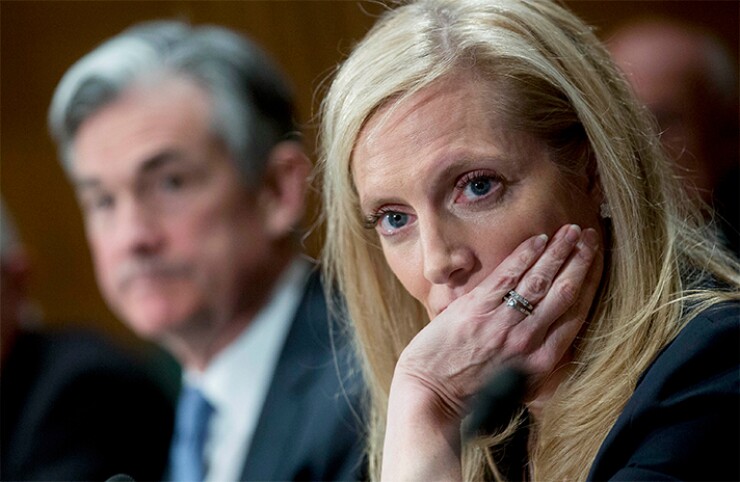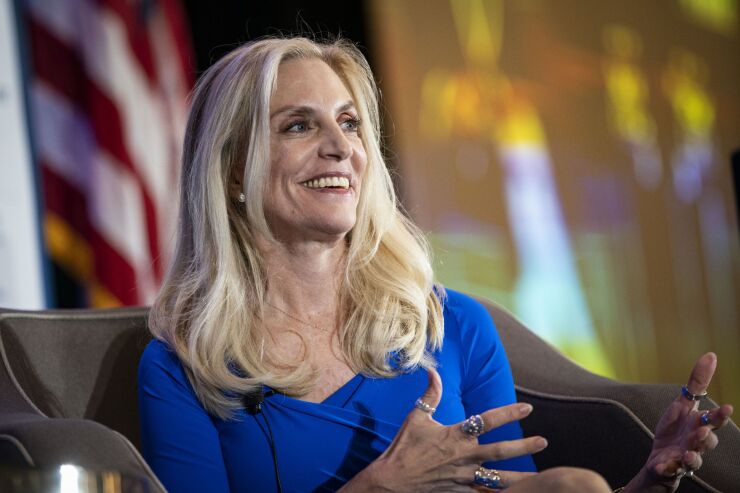Banks have less than a year to prepare for the launch of the Federal Reserve's long-anticipated instant payment system. It remains unclear just how many will bother.
In a
Banks will have to weigh the cost of these changes not only against the benefits offered by FedNow, but also against the alternative: The Clearing House's RTP Network.

Active since 2017, RTP has the backing of the biggest banks in the country — 18 of which are members of The Clearing House — as well as more than 250 other institutions. In total, it estimates its total reach to be more than 60% of U.S. demand deposit accounts. Russ Waterhouse, executive vice president of product development and strategy at The Clearing House, said RTP has had a significant head start over FedNow, an advantage that won't easily be overcome.
"FedNow is going to have a pretty tough go because they've got to convince institutions to join when the products, the functionality and the volume of the reach is already on RTP," Waterhouse said. "What is their value proposition? Finding that unique value prop is probably the hardest thing they're going to struggle with."
More than 120 institutions — ranging from payments-focused fintechs to large bank holding companies, including several Clearing House members — are participating in a pilot program for FedNow, which begins technical testing this month. These groups will be positioned to connect to FedNow as soon as it goes live.
Dan Awrey, a Cornell Law School professor who specializes in financial regulation and corporate law, said the market for additional FedNow participation will be composed of banks that are both eligible for Fed payment accounts and interested in instant payments but not already wedded to RTP.
Awrey said it is tough to estimate just how many institutions fall within that nexus. Without knowing exactly how FedNow will function, it is impossible to predict just how strong demand for it will be, he added.
"We don't know what FedNow is from a technological perspective, and we don't know what it will mean for its intended audience, which is non-RTP banks," he said. "It won't improve on RTP because the only way to do that is by expanding the amount of groups that have access to the system, and the Fed — through its recent guidance on master accounts access — has indicated that it isn't willing to do that."
The bulk of demand for FedNow is likely to come from small banks that have not made the financial commitments to RTP that their larger counterparts have, Awrey said. However, he noted, FedNow will by no means have that market cornered, given that many small banks and credit unions can access RTP through relationships with large banks and third-party payments processors.
"All these banks are served in one way or another. You have smaller banks with direct access to the existing system or relationships with Clearing House banks," he said. "FedNow has to be better than both those options."
Some smaller banks believe there's at least a chance that it will be.

Nick Denning, senior vice president of payments industry relations for ICBA Bancard, the payments subsidiary of the Independent Community Bankers of America, said that many community banks have held off on entering the instant payments market until FedNow goes live.
"The true value of instant payments to community banks will be when … you have all the sending and receiving institutions participating in instant payments and able to deliver that value forward to their consumers," Denning said. "Community banks are waiting for that scale to start to be achieved, and they're anticipating FedNow will help bring that to instant payments."
Denning said that while community banks
"We've been doing webinars and educational outreach and trying to just encourage and get that momentum going for instant payments throughout the year," he said. "This particular time frame gives us added juice to get banks motivated and moving forward."
There is a skepticism within the banking industry that FedNow will be able to catch up with RTP, and some see the race as a zero-sum game, given that the two systems, at least initially, will not be interoperable with one another. A spokesman for U.S. Bank, a new addition to the FedNow pilot and leading processor on the RTP system, has said that it plans to offer interoperability between the two systems for customers, but it is not clear what that would do to the speed of payments.
"Much of the groundwork will be laid for when FedNow goes live," a U.S. Bank spokesperson said. "We will be ready to offer interoperability between the rails so our customers have access to the services that work best for their needs."
Further challenging the Fed's competitiveness is a stipulation from the cost recovery requirement established by the Monetary Control Act of 1980, which effectively forces the Fed to add a mark-up to its services in line with the profit margin sought by private competitors. This limits its ability to undercut the market. FedNow's prices will be equal to those of RTP.
Still, Gilbert Schwartz, a Washington-based lawyer specializing in payment systems and a former Fed general counsel, said the Fed has a long history of dominating payment processing because of its baked-in access to so many banks. He said The Clearing House and the rest of the banking world should be prepared for the same trend to play out on the instant payments front.
"There is a possibility that, ultimately, there will only be one instant payment provider in the U.S. — the Fed," he said. "Institutions will have to join to stay competitive, and the fact that the Fed is hooked up to virtually every institution already is a big advantage."





